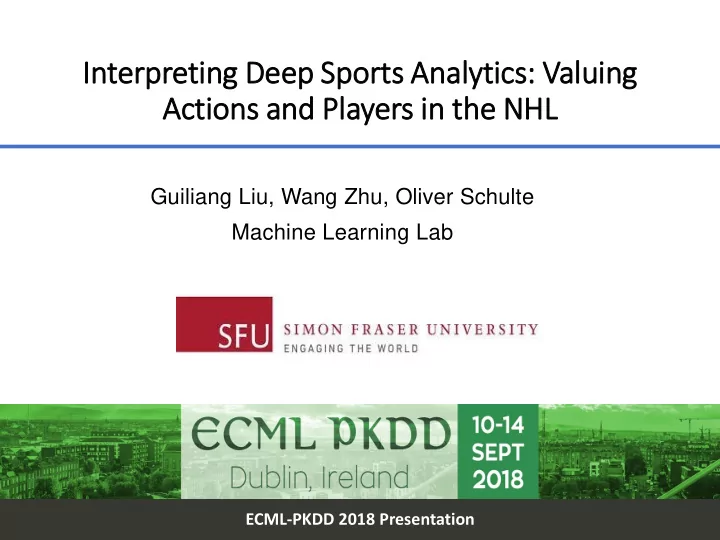

In Interpretin ing Deep Sports Analy lytics: Valu luin ing Actio ions and Pla layers in in th the NHL Guiliang Liu, Wang Zhu, Oliver Schulte Machine Learning Lab ECML-PKDD 2018 Presentation
Problem Understand the Deep Reinforcement Learning (DRL) Model in National Hockey League (NHL) Problem
DRL Model: Previous Work Liu and Schulte IJCAI 2018 Department name/presenter name
Dataset • Game events and player actions for the 2015-2016 NHL season. • Augment the data with derived features (red lines). • Divide NHL games into goal-scoring episodes that • Begin at the beginning of the game, or after a goal. • Terminate with a goal, or the end of the game. Dataset
DRL Model • Estimate chance that team scores the next goal given current match state and action = 𝑹 𝒖𝒇𝒃𝒏 (𝒕, 𝒃) . • Recurrent network with dynamic trace length LSTM. Temporal Projection: evolution of Spatial Projection (for shot): The probability scoring probabilities for the next goal that the home team scores the next goal after taking a shot at a rink location DRL Model (Liu and Schulte IJCAI 2018)
Goal Impact Metric • 𝑱𝒏𝒒𝒃𝒅𝒖(𝒕 𝒖 , 𝒃 𝒖 ) m easures the quality of action 𝑏 𝑢 by how much it changes the expected return of a player's team. 𝑗𝑛𝑞𝑏𝑑𝑢 𝑢𝑓𝑏𝑛 𝑡 𝑢 , 𝑏 𝑢 = 𝑅 𝑢𝑓𝑏𝑛 𝑡 𝑢 , 𝑏 𝑢 − 𝑅 𝑢𝑓𝑏𝑛 𝑡 𝑢−1 , 𝑏 𝑢−1 Difference of consecutive Q values • Define Goal Impact Metric (GIM) of player 𝑗 by the total impact of a player in entire game season dataset 𝐸 . 𝑗 𝑡, 𝑏 × 𝑗𝑛𝑞𝑏𝑑𝑢 𝑢𝑓𝑏𝑛 𝑗 (𝑡, 𝑏) 𝐻𝐽𝑁 𝑗 (𝐸) = 𝑜 𝐸 𝑡,𝑏 Goal Impact Metric
Goal Impact Metric • The Impact metric passes “eye test”. • Correlates strongly with goals, points, salary, etc. in NHL. • Consistent between and within seasons. • All actions including defensive and offensive actions. Goal Impact Metric
Interpreting the DRL Model Department name/presenter name
Model Mimic Learning Framework for General Model : • Mimicking Q functions and impact separately. • History Window of last 10 observations. • A Multi-variate Regression Tree (MRT) trained with CART method. Model
Model Player Specific Model : • Inherit the tree structure of the general model . initialize General tree • Use the target player data to prune prune the general model. • Use the same player data to expand expand the tree. Player tree e.g. Sidney Croby Model
Model DEL Mean Sample Leaf (MSL) : • Control the minimum number of samples at each leaf node. • Satisfactory performance when MSL = 20 . Model
Feature Importance Rank feature by average variance reduction: • Find the top 10 important features using general model . • The impact function recognizes shooting, successful actions. • History Window is necessary. Feature Importance
Partial Dependence Partial Dependence plot: • Use general model to interpret Q functions and impact. • Select Time Remaining, X Coordinate and X Velocity to visualize. Partial Dependence
Exceptional Players Find the most unusual players: • Use player specific model to compare the whole dataset (general data) and player specific data. • Joe Pavelski scored the most in the 2015-2016 game season. • Erik Karlsson had the most points (goal+assists). Exceptional Players
Thank You! For more information: Poster: #xxx Homepage: http://www.galenliu.com/ Q&A
Exceptional Players How to find the most unusual player: • Focus on top players • For each player specific model : • For each leaf in the tree • There is an original value (e.g. ) 𝑄 𝐽 𝑚 • Learn a value based on the whole dataset ( ) 𝐽 𝑚 • Weight by the percentage of cases that get to the leaf ( 𝑜 𝑚 /𝑜 𝐸 ) 2 𝑄 − 𝐽 𝑚 • Sum over squared differences 𝑜 𝑚 /𝑜 𝐸 𝐽 𝑚 Exceptional Players
Recommend
More recommend